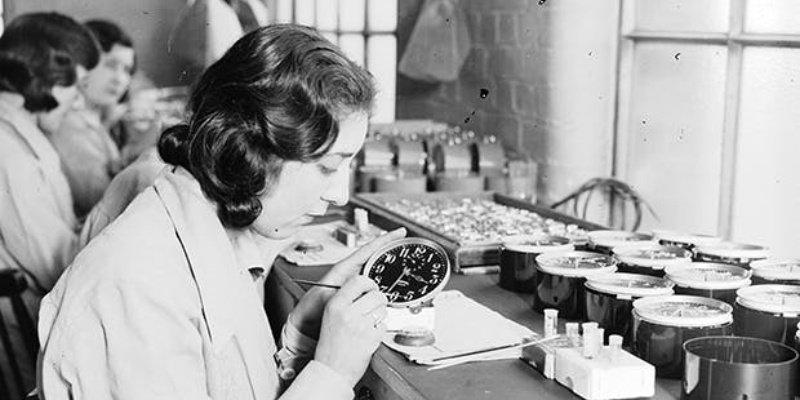Haunting. That’s the word that stays with me at the end of this one. The Radium Girls: The Dark Story of America’s Shining Women by Kate Moore is a heart-rending true account of the female “dial painters” of the 1920s and 30s. It’s a story of discovery and optimism turned dark and dangerous, showcasing both the best and the worst of human nature and the risks that are ever present as we push the limits of our knowledge.
Radium was first discovered in 1898. In the years that followed, its seemingly otherworldly powers born of this mysterious new “radioactivity” captivated the world. Radium was touted as a cure-all health boon spawning an industry in radioactive tonics, spas and clinics for the uber-wealthy. However as the world plunged into World War I, radium was perhaps most valuable for its luminous glow – used in paint solutions to create glowing numerals on watchfaces and dials, most of them for military use. This work of dial painting was done almost exclusively by young, in many cases teen aged, working class women in places like Orange, New Jersey and the small town of Ottawa, Illinois.
Imagine the thrill for these girls to land one of the most sought-after jobs of the day. Not only did they get access to this miracle element, the most expensive substance on earth, but they earned in many cases two or three times what they otherwise would have and it was all in support of the war effort. It was a sociable setting where the girls chatted and became friends as they carefully painted those luminous numerals with thin artist’s brushes which they were coached to point by putting them in their mouths as they worked. When they left the studio, the glow of the radium dust that covered them went with them, transforming their dresses, their hair, their skin with its soft glow. They were glamorous, envied and unconcerned – counting themselves lucky to have the added benefit of exposure to the radium and even playing at painting their faces, lips and teeth with the leftover material.
Now imagine the horror as the real effects of exposure to radioactivity began to set in. Of course by the time those girls were pointing and painting, science had plenty of evidence to demonstrate how harmful and dangerous radium could be. The general working class public though was not privy to those kinds of discussions which were generally limited to scientists, doctors, researchers, the academic and the elite – including the executives employing the dial painters. To propagate this knowledge that radium could in fact be harmful by publicizing the facts or even instituting safety procedures for the painters could only cut into business, profits and an eagerly available work force. So they simply didn’t. The legacy of that decision would play out for years to come in the shocking and often horrifying suffering of the former dial painters as they one after another fell ill as well as in their arduously lengthy legal battle to hold the companies accountable.
I will say up front, Moore’s writing style in this case is quite technical, sometimes repetitive, and the sheer volume of facts, figures and details that are crammed in make this book feel at times more like a research paper than a personal story. But I determined to push on for the sake of the story, and I’m glad that I did. In truth, the most amazing thing of all was that I had never heard the story of these women. Even in all my ample nerdy indulgence in non-fiction, history and science reading, watching and listening, never once had I come across this story. And that is astounding, not only because these women deserve to be recognized and remembered, but also because this is a story that continues to reverberate in a very real way today.
The radium girls were victims of the very worst kind of corporate greed in which profits outweighed human life itself. The companies that employed them however were unabashed with a cold calculation that makes this feel much more like a story of premeditated murder than “industrial poisoning” or “workplace injury”. Hopping from one state to another to avoid detection and legal responsibility, the company men carried on and on, undeterred by the real horror in front of their eyes. Far from just concealing the truth, they actively lied to their workers and to the public, even taking out advertisements in the newspaper to extol the virtues of radium and the glowing good health of their girls. It serves as a chilling reminder of just how inhumane humans can be.
This story is bigger than just the companies though. The women’s fight for justice, while powerless to save them from the sinister lurking of radium in their very bones, did in many ways make it possible for those who came after them to work safely as the nuclear age dawned. Not only did they make public the very real dangers of exposure by sharing their stories and medical histories, but many of them donated their bodies to science upon their deaths allowing vital research into the effects of radioactivity on the human body. That knowledge helped to form safety protocols that would protect everyone from future factory workers to the scientists and researchers of the Manhattan Project and eventually even those living in nuclear test site fallout areas.
How many more hidden dangers lie ahead as we continue to push the boundaries of our science and technology? How many more are willing to sacrifice lives for the gain of profits? How many more will suffer? How many more will have the courage to stand up? These are questions not just for the radium girls, but for each and every one of us today and every day.
Photo courtesy of https://www.spectator.co.uk/2016/06/the-radium-girls-still-glowing-in-their-coffins/




